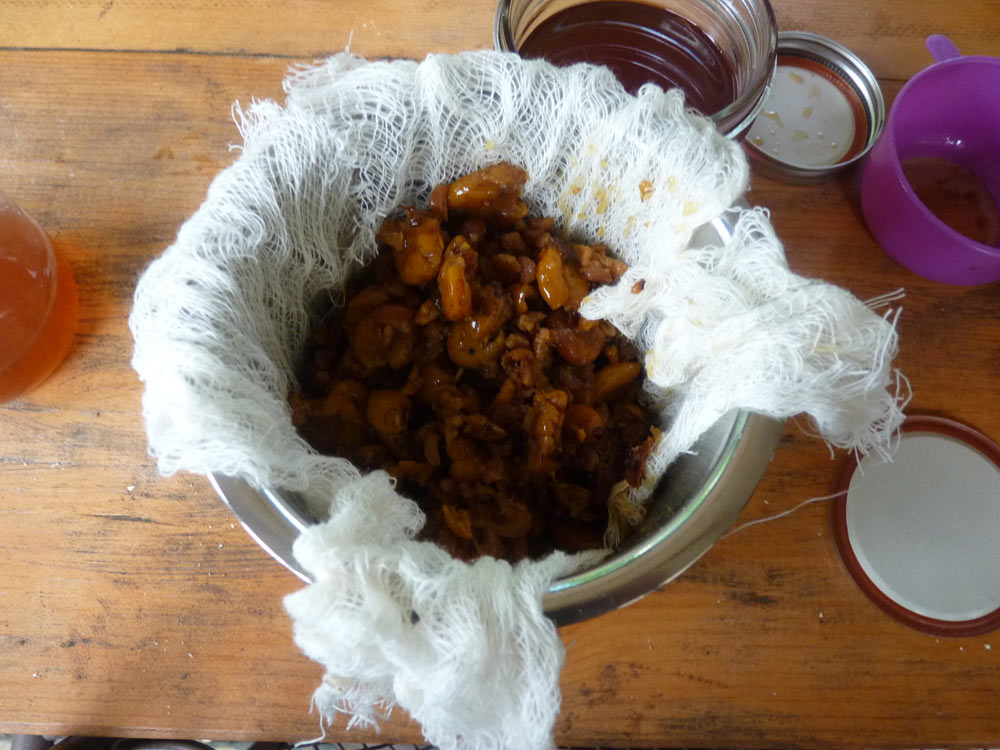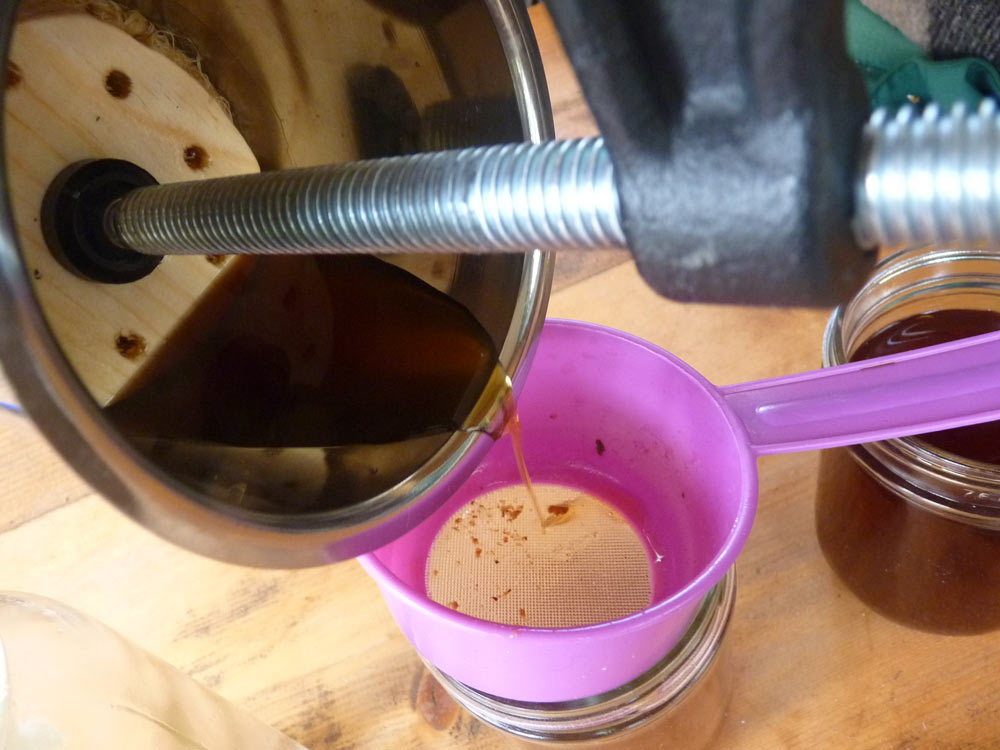One of the primary methods of extracting and preserving the medicine of the plants is by creating healing tinctures, either magical or mundane. This involves maceration (soaking) herbs in alcohol, pressing the alcohol out, and depending on the purpose that you are creating the tincture for, maybe adding a few more steps. I wrote about tincture making last year in two posts, and you can learn the basic steps here for a magical tincture and here for bitters.
As I’ve mentioned before, I’ve been engaged in dedicated study of plants and their sacred medicine. This is taking place on multiple levels–studying Traditional Western Herbalism through a year-long course, working with the plant spirits themselves, and continuing to engage in gardening, foraging, and work on sacred trees. In the last year, I’ve made about 30 different medicinal tinctures. For a standard medicinal tincture, after the alcohol has been extracted the medicine of the plant, you want to press as much of the alcohol out of the plant matter as possible (a gallon of neutral high proof organic alcohol is around $80). A search for tincture presses reveals most cost several hundred dollars, at minimum.
I looked at a few instructions online and came up with my own design that may not exactly look pretty, but works really quite well. Its based on the idea of a fruit press, which I’ve used to press out grapes for jelly. My tincture press cost me $30 to make, total, and that was with all new materials. If you have some of the materials lying around, you could save some funds. I should add that I have limited woodworking skills, and if I can make this, so can you!
Supplies:
- One very large C-clamp (probably the largest you can find); I found mine at a home improvement store
- One stainless steel cylinder (you can get this at a restaurant supply store; I bought mine online).
- Cheesecloth for pressing (can be reused if washed carefully)
Tools:
- Coping saw or another way to cut two wooden circles
- Pencil for drawing lines
- Sandpaper
- Drill and large-ish bit
- Epoxy or some other glue (ONLY for outside of the press, see instructions below)
To make:
1) Start out by figuring out what size of wooden disks you will need and trace your circles in pencil. You will need one wooden disk to support the bottom of your metal cylinder, and you’ll need a second to function as the “press” inside. I found that a canning jar lid worked well for the size I was looking for.

2) Cut out your circles. I learned through this process that my coping saw skills leave much to be desired–but in the end, I had two circle-ish wooden disks.

3) Drill some holes in one of your disks; the one designed to go into the press itself.

4) Sand your disks, making sure your pencil marks are sanded off and the edges are smooth.

5) Glue your second disk onto the bottom of the metal cylinder–this will hold it in place and make pressing much easier. I’ve done this step since I took these photos; it is easier to use now.
Now you are ready to press!
To use your press:
1) Start by straining off your herbs into a clean jar (I use a simple plastic strainer, and I let them drip out for a bit). These are hawthorn “haws” that I made into tincture last November.

2) Place the cheesecloth inside your metal cylinder, making sure it will be sufficient to cover your herbs (I’m using a lot here because there are a lot of haws). Take your herbs out of the strainer and add them into the cheesecloth.

3) Get your press ready–make sure your wooden disk is supporting the bottom and put your disk with the holes on top of the press. Get your c-clamp into place for the pressing action.

4) Begin pressing, and spinning your handle of the C-clamp in a clockwise fashion. You’ll feel the tension as the herbs are pressed down.

5) After pressing for a bit, tilt your c-clamp and pour your tincture off. You can continue to press and pour off your tincture till its too hard to press further. You’ll notice I’m sending it through a strainer to get out any plant material–but I didn’t see any coming out of the press.

A few other notes about using this press:
1) Some of the alcohol will absorb into the wood. I sealed my wood with melted beeswax and that helped quite a bit!
2) I have found that only “spongy” material is worth pressing. The hawthorn pressed well and I got a lot more tincture through pressing. I also pressed a white willow bark tincture–I got literally nothing out of pressing because the bark was woody, not spongy, so it didn’t absorb the alcohol. Keep this in mind and save yourself some trouble by only pressing material that will actually gain results.
3) You can use this press to press other things, like an herbal oil, if you desire. I’d clean it really well between uses, and I’d seal the wood for sure if you are pressing oil (alternatively, you can cut yourself a third disk for oils and use that exclusively with the oils).
There you have it–a simple and practical way to get all the medicinal goodness out of your tinctures! I’ll be posting more about the kinds of plants I’ve made into tinctures this year and sharing more of my herbal journeys.




Reblogged this on The Coastal Affair and commented:
Check out another awesome post from one of our favorite bloggers!!
Thank you! 🙂
pretty cool! I haven’t commented much lately, but I’m still enjoying your always informative, practical AND magical blog!
Thank you Justin! Great to hear from you :).
That is really interesting. Making tinctures isn’t something I’ve tried, but seeing what you have done means I know where to come in the future, should I decide to start. 🙂
I’m going to have a few more posts in the next few months on herbalism, tincture making, medicine making, and the like. Stay tuned–and I’d love to hear about what you decide to do! 🙂
Could you say more about the wood you used? What type? How thick? Thanks!
Yeah, I used some pine board. It was 1″ thick board, completely untreated (obviously be careful of the wood’s source for this!) It worked fine for me, but when a friend who is stronger than me borrowed the press, he broke the board :P. So he made me a new board that was with 2″ thick pine. That sucker isn’t going to crack! 🙂
Thanks for getting back to me. One more question: did you replace only the wood inside the cylinder–or both the inside one and the outside on? Thanks!
Only the wood on the inside–the wood on the outside, since it was glued to the bottom of the cylinder, held up just fine.
Reblogged this on The Crane Book of Wisdom and commented:
Posting this since Druids are known to healers…
What size in diameter was the cylinder? 3in, 7in?? Sorry had to comment again b/c I didn’t click the email update
The one that I used was about 3″ across and 7″ high. I hope that helps!
Thank you for posting this. Great idea!
You are most welcome, Theresa! It still works well for me 🙂
Nice work. Simple and effective.
Hey, no bs….that’s a pretty good little press.
Thank you! Yes it certainly is!